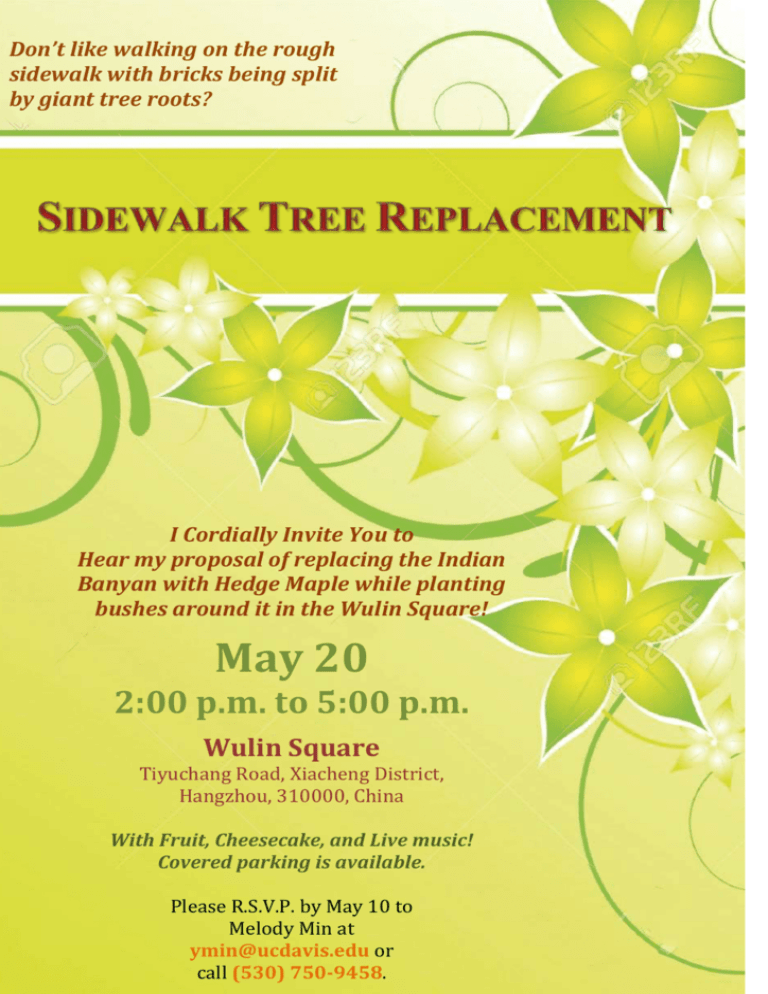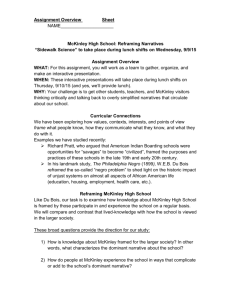Sidewalk Tree Replacement Project
advertisement

Don’t like walking on the rough sidewalk with bricks being split by giant tree roots? I Cordially Invite You to Hear my proposal of replacing the Indian Banyan with Hedge Maple while planting bushes around it in the Wulin Square! May 20 2:00 p.m. to 5:00 p.m. Wulin Square Tiyuchang Road, Xiacheng District, Hangzhou, 310000, China With Fruit, Cheesecake, and Live music! Covered parking is available. Please R.S.V.P. by May 10 to Melody Min at ymin@ucdavis.edu or call (530) 750-9458. Melody Min UWP 023 2015/5/13 Sidewalk Tree Replacement Project Motivation My project aims on improving the plants on the sidewalk in my hometown Hangzhou at Wulin Square, which is the city center. It is an old district where the bricks on the sidewalk are split by giant tree roots, which make the surface hard for people to walk on, especially for seniors. Last year, my grandmother was tripped by one big tree root on the sidewalk when she was on the way to shopping at supermarket. Fortunately, two kind-hearted men drove her to hospital, and she suffered only cuts and bruises without breaking bones. Sometimes, falling down can be extremely serious for old people because their bones are much more fragile than young people’s. After that accident, I searched online and found several news about people being tripped by the tree roots on sidewalk. Because of I’m interested both in the safety of others and having green beauty in the city center, I decided to make a plan of improving the plants on the sidewalk by replacing the giant trees with Hedge Maples and meanwhile planting shrubs, which are “low woody perennial plants usually having several major branches but without big roots”(the free dictionary), around them. Moreover, Hedge Maple not only always provides more leaves and shade than Indian Banyan, which is the major type of tree on the sidewalk currently, but also it’s growth needs less care from people. Greening Project Proposal (Indian Banyan’s roots exposed on the sidewalk) Current Condition at Wulin Square In Hangzhou, the most common tree on the sidewalk is Indian Banyan, which is wonderful long-lived and sturdy tree. Indian Banyan usually has several branches with considerable leaves, which provide numerous green shades, that simply requires more root and trunk space than the 6 foot swale designated by the designers. Especially when it grows old, its roots become giant. In some old districts like Wulin Square, as the photo above shows, the bricks on the sidewalk are split by these tree roots, which make the surface hard for people to walk on, especially for seniors. Every year, many accidents of pedestrian being tripped by the roots on the sidewalk are reported by the news, and most victims are old people and women with high heels. In addition, since the sidewalk is damaged, some pedestrians decide to give up it but walk on the bike lane or the vehicle lane, which also is a hidden risk of traffic accident. Last but not least, from the aesthetic aspect, the tree roots damage the beauty of greening without providing pleasure to residents’ eyes. (Ideal Projection) Improvement Because removal of the trees by sidewalks is not practical, sometimes not allowed by local ordinance, and would remove an important environmental amenity from streetscape, in order to reduce the risk of people being tripped by the giant roots, the option is to replace the Indian Banyan with Hedge Maple while planting bushes around it just like the photo above shows. According to forestry expert Steve Nix “Hedge maple tolerates urban conditions with no serious pests or disease problems. Acer campestre also tolerates dry soil, compaction and air pollutants. The small stature and vigorous growth of hedge maple makes this an excellent street tree for residential areas, or perhaps in downtown urban sites. It is also suitable as a patio or yard shade tree because it stays small and creates dense shade.”(Nix, 2013) As for the shrubs, Chinese holly is an appropriate choice. It will survive the road salt while beautifying the 6 foot swale and preventing pedestrians stepping on it. Maintenance Since bushes grow rapidly and need to be pruned frequently, it provides an excellent opportunity for children to be a part of the project. Each elementary school would be responsible of taking care of the shrubs in its district. The first Wednesday of every month, the city landscape gardeners will go to the local elementary schools and take the upper level children to the area that they are responsible for teaching them watering the greens and trimming the bushes on the sidewalk. (The sidewalk becomes good for walking) Benefits 1. Pedestrian Safety According to the Hangzhou Daily, last year 12 people were tripped by the big tree roots on the sidewalk, and 8 of them were seniors(Junfeng Zhou, 2014). Fortunately, most of them only had some light wounds. However, 2 victims hurt their heads, which caused brain damage in some degree. By replacing the Indian Banyan with Hedge Maple, there will be no roots on the ground, so nobody will be hurt by the tree on the sidewalk anymore. 2. Aesthetic As a tourist city, Hangzhou is famous of its natural beauty. However, the tree roots that exposed on the sidewalk are incompatible with the beautiful city. Like the photo above shows, by surrounding the tree with shrubs, the sidewalk becomes scenery as well, which will catch more tourists’ eyes and even attract more tourists come to visit Hangzhou. 3. Nature Deficit Disorder Today, children are always distanced from the natural world due to heavy load of studying, attraction of technology, and busy parents, who have no time to take their children outsides. Obesity develops based on this lack of being touch with nature, which becomes a serious problem in the United States. “Medical costs associated with obesity and inactivity are nearly 150 billion dollar a year”(Timothy Egan, 2012). However, according to Jon Henley, “Just five minutes' "green exercise" can produce rapid improvements in mental wellbeing and self-esteem, with the greatest benefits experienced by the young”(Jon Henley, 2010). By participating the maintenance of the project, elementary school children can have the “five minutes” to gain both mental and physical benefits from nature. Moreover, once the sidewalks are safer, it will be easier for people of all ages to spend time walking in the city. Potential Challenges The Indian Banyan is not always easy to remove. It takes gardeners several days to dig out all the roots and make plan to lift it up. In order to do so, the sidewalk has to be closed until the tree is removed completely, which is unconvinced to pedestrians who usually walk by this sidewalk or the stores on the street. Constrictions always bother people, however, the outcome of the project greatly benefits the residents near Wulin Square, so the project is worth to be chosen. Conclusion Replacing the Indian Banyan on the sidewalk with Hedge Maple while planting bushes around it not only solves the hidden danger for safety, but also provides elementary school children a chance to be in touch with the natural world and learn how to take care of plants regularly, which is proved to have significant health benefits on both mental and physical by medical researchers. Meanwhile, adults who used to prefer driving than walking due to the uneven sidewalk will now rejoin the walkers. Walking periodically as an exercise can greatly reduce the risk of being obese. Moreover, without the tree roots exposed on the sidewalk, Hangzhou will be a more glamorous city and attract more tourists to come and visit. References Egan, T. (2012, March 29). Nature-Deficit Disorder. Retrieved May 15, 2015, from http://opinionator.blogs.nytimes.com/2012/03/29/nature-deficitdisorder/?_r=0 Henley, J. (2010, August 16). Why our children need to get outside and engage with nature. Retrieved May 13, 2015, from http://www.theguardian.com/lifeandstyle/2010/aug/16/childre-natureoutside-play-health Nix, S. (2013, July 20) Best Trees to Plant on Your Street and Sidewalk. Retrieved May 13, 2015, from http://forestry.about.com/od/urbanforestry/tp/street_trees.htm Zhou, F. (2012, June 3) Tree Roots on the Sidewalk Tripped 12 People. Retrieved May 13, 2015, from http://hzdaily.hangzhou.com.cn/hzrb/html/201506/05/node_830.htm






